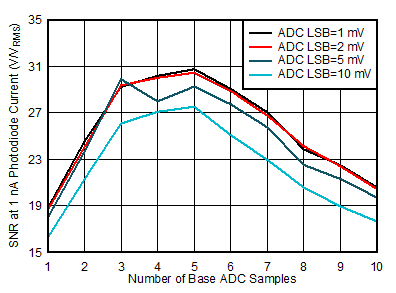SLVAEX3 October 2020 TPS8802 , TPS8804
4.3.7 ADC Resolution
The ADC resolution can have an effect on the SNR if it is too low. ADC LSB sizes of 1 mV, 2 mV, 5 mV, and 10 mV are simulated by rounding the waveform to the nearest LSB in MATLAB. The SNR starts to drop when the LSB size is 5 mV or above. If the LSB size is greater than the noise or signal level, increase the photo amplifier gain using the RPH resistor or programmable gain stage.

| tLED=100 µs | τ1=15 µs | τ2=15 µs |